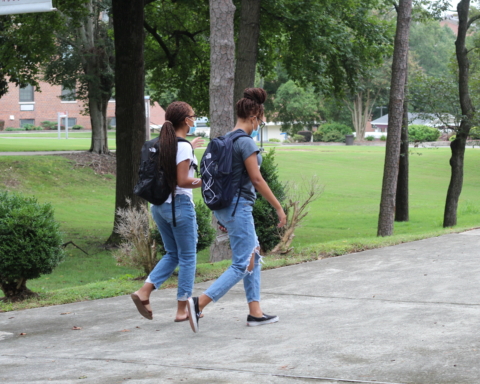DURHAM — Their eyes are still tightly shut and they can’t quite howl just yet, but Durham is welcoming three new wolf pups to the highly endangered pack.
Fewer than 300 red wolves are alive today. A female at the Durham Museum of Life and Science gave birth to a litter of pups on April 21.
The museum announced the births of the pups on Facebook. Staff found three pups total: two males and one female. All were in good health.
“With fewer than 300 red wolves alive today, we’re excited to welcome these new additions to this critically endangered population,” the museum wrote.
For now, the pups are being called “A,” “B” and “C.”
The first pup, “A,” was a large, feisty and vocal male. He weighed 420 grams, according to Animal Department director Sherry Samuels. “B,” also a male, was 342 grams, and “C,” the only female, was 350 grams.
While the wolves will remain in their “Explore the Wild” habitat, visitors probably won’t see the pups just yet. The pups and their mother will likely spend a majority of their time in either the provided den or in one of the dens dug by the female, the museum said.
The first 30 days are a particularly critical time for wolf pups, and museum staff will be monitoring them closely.
“The next month is filled with lots of work and so many emotions — covering the spectrum from excitement to fear,” Samuels said. “This first month is a critical time, and survival is not guaranteed. Every day the pups survive is a good day. One good day down. Hopefully many more to come.”
Pups typically begin to open their eyes 10-14 days after they are born, but the newborns likely won’t spend much time out of the den until early June.
“Until then stay tuned for more pics, videos & updates from our Animal Department. What questions do you have about our newest arrivals?” the museum wrote on Facebook.
For those eager to get a peek at the pups, or red wolves at the museum in general, Samuels offered a few tips:
- Practice the skills used by wildlife biologists observing red wolves in the wild: Stay calm, remain quiet and keep a close eye out – calm and quiet observation is key when viewing the new pups.
- Take your time and visit regularly. Pups will become more active over the course of the summer.
- Look for museum staff at the wolf habitat throughout the summer to answer questions and keep you updated on the latest developments.
Story by Abbie Bennett
News & Observer (Tribune News Service)



















